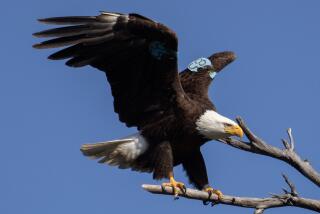BREEDING BIRDS: BROWN-HEADED COWBIRD : BROWN-HEADED COWBIRD (Molothrus ater)
- Share via
Description: Male’s brown head contrasts with metallic green-black body. Female is gray-brown above, paler below. Habit of feeding with tail cocked up distinguishes species in
mixed blackbird flocks.
Habitat: Open woodlands, farmlands, suburbs.
Diet: Insects, spiders and seeds.
Displays: On ground, courting male ruffles feathers of upper body, bows toward female and calls.
Nest: The brown-headed cowbird does not
build a nest of its own; it is a nest parasite, laying eggs in nests of other species, including flycatchers, warblers, finches and vireos.
Eggs: White to grayish-white, marked with brown; less than an inch long.
Natural history notes: Native to the Great Plains, where it once followed the huge herds of bison, the brown-headed cowbird spread its range to both coasts with the settlement of the country. It was unknown in coastal Southern California before 1915; today it is among Orange County’s most common birds. Its success has come at the expense of several native pecies. The cowbird lays its eggs in the nests of other birds, which act as surrogate parents to the growing chicks, often at the expense of their own chicks (the large cowbird chicks outcompete their nestmates for food from the parents). Riparian species, such as the endangered least Bell’s vireo and the willow flycatcher, are especially affected by parasitism; other local species in decline because of the cowbird include the yellow-breasted chat, warbling vireo, yellow warbler and Swainson’s thrush. The cowbird also lays its eggs in the nests of larger birds, including hooded orioles and red-winged blackbirds. But because the chicks are of similar size to the cowbird they are better able to compete.
Breeding bird atlas: To report bird breeding activity in your neighborhood, or to get information on the breeding bird atlas (now in its fifth and final year), call Sea and Sage Audubon Society members Sylvia Gallagher, (714) 962-8990, or Nancy Kenyon, (714) 786-3160.
Note: Map is divided into 5-kilometer squares so that Audubon Society volunteers can more easily survey areas on a regular basis.
Sources: Sea and Sage Audubon Society; “The Birder’s Handbook,” Ehrlich, Dobkin and Wheye, Fireside Books (1988); “Field Guide to the Birds of North America,” National Geographic Society (1987); “Birds of Southern California: Status and Distribution,” Garrett and Dunn, Los Angeles Audubon Society (1981).
More to Read
Sign up for Essential California
The most important California stories and recommendations in your inbox every morning.
You may occasionally receive promotional content from the Los Angeles Times.













